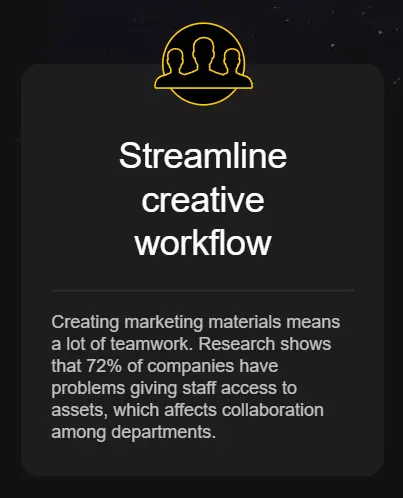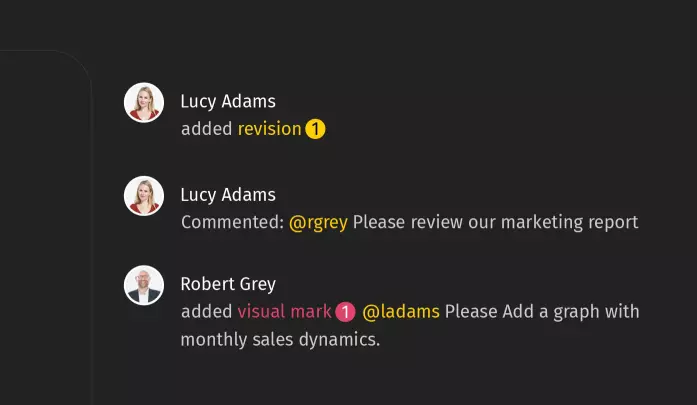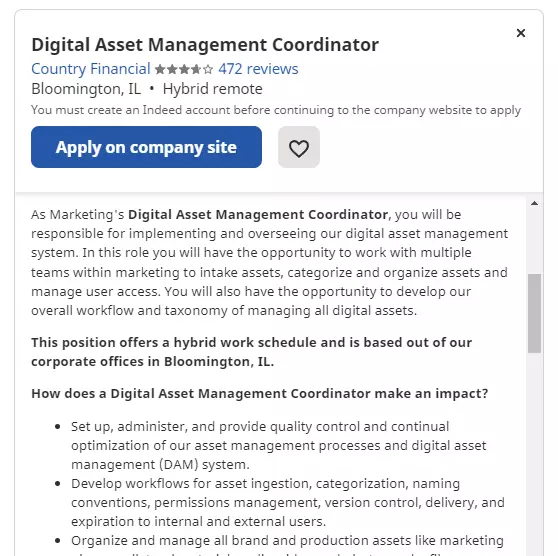In this article, you’ll learn:
From streamlining processes to working with the best, fastest tools, businesses have never been more eager to become efficient at everything they do.
The problem?
Digital marketing needs are increasing at a rapid rate — and keeping up with the demand is going to be a challenge.
Unfortunately, no business is immune. Even the finest marketing teams can run into snags when balancing everything.
So what’s the missing piece here? Beyond being able to conduct proper industry research, deliver value, and strategize campaigns?
Having a digital asset management (DAM) strategy.
I can’t stress enough how much my wedding photography business suffered from not having a DAM strategy.
I can’t stress enough how much my wedding photography business suffered from not having proper digital asset management strategies
My logo, website elements, and graphics? I stored them in various desktop folders on my computer. My client’s photos, products, and orders? They were somewhere between my Gmail account, Google Drive, and Adobe Lightroom.
Planning social media campaigns took weeks, if not months. I wasted hours trying to remember where I stored my assets. And suffice it to say, my clients suffered, too.
It wasn’t until I employed a DAM strategy that my business started to take off.
Let’s take a closer look into what DAM really means — and six ways it’s expected to change in 2022.
What’s digital asset management?
DAM is a software solution that helps people solve problems they run into when working with assets.
When I say “assets,” I don’t mean the kind you read about on investment advice websites. I’m referring to the digital assets your team uses every day to create campaigns, design logos, send emails, or anything else.
I’m referring to electronic files, copies, or programs you might use daily, like:
- Text files
- Photos
- Videos
- Design files
- Word docs
- Pdfs
- Slideshows
- Digital flyers
- Logos
- Graphics
- Raw files

Some common problems businesses run into when they don’t have a DAM solution include:
- Having trouble locating files
- Experiencing information silos
- Lacking team collaboration features
- Lacking access to the newest file versions
With the right DAM solution, businesses can avoid these challenges and equip their teams with the tools they need to thrive.
6 ways DAM is expected to change in 2022
With a higher demand for asset management than ever before, it’s vital to stay on top of advancements and changes in the DAM world. Let’s look at six ways DAM is expected to change in 2022.
1. Asset-based workflow solutions
Asset-based workflows will be all the rage in 2022, with their promise to help teams optimize the DAM process from start to finish.
Businesses that need to create, approve, and prepare assets, will especially benefit from asset-based workflows.
For instance, if you’re a designer, marketer, or PR rep, you likely have files thrown at you left and right. You probably have initial images and copy to approve, samples to send to clients, final copies to review, and that’s just skimming the surface.
You could choose to manually tackle each task as it comes. Or, you could choose to create a step-by-step system to handle all tasks in an efficient, specific order. And, you could also choose to automate some of those tasks, to shave even more time off your schedule.
Sounds too good to be true? It’s not. That’s the benefit of using asset-based workflows.
2. Unique security solutions
Unique security solutions are coming in 2022 to protect businesses from potential data leaks and asset loss.
Here are three examples of DAM security features businesses will be taking advantage of in 2022:
Identity security measures
Core identity security measures will be implemented to audit automation scripts and prevent data leaks and asset loss.
Enterprise data warehouses
To protect against significant data loss, more businesses will employ an enterprise data warehouse (EDW). An EDW can be used to backup company databases and sensitive data.
Think of it as a database of databases.
Secure data collection
More solutions are coming for businesses that collect zero-party data (data voluntarily given by their customers).
From acquiring digital assets to capturing lead information, businesses will have better ways to ensure their practices align with Google and country standards.
3. Asset centralization and accessibility
One of the biggest things to watch out for in 2022 is improved asset centralization and accessibility.
Remember the way I managed my assets before I employed a DAM strategy? I had files scattered all over the place, as many businesses do.
I’m sure you can think of several unorganized assets you have, just off the top of your head.
The issue with scattered assets is that they waste time. The average person looks for a media file 83 times a week and fails to find it 35% of the time. For many professionals, like marketing teams, that’s a poor use of time and resources.
But with an organized digital library with tags, categories, and metadata, assets are easy to spot and use. No more missing marketing materials. No more starting from scratch. No more confusion.
You can find and reuse your assets quickly and easily — and you can share them with the right people at the right time.

Here are some additional benefits that come with asset centralization and accessibility:
- Speedier process of sorting, storing, and searching for materials
- Easier to promote team collaboration
- Easier to create asset-based workflows
- You can use your existing Google Drive account — no need to manage multiple cloud storage platforms
- Closer access to the ‘big picture’ (regarding what assets you have and are currently using)
- No more information silos
4. Real-time updates and transcripts
Staying informed about the latest changes to your digital assets is vital to keeping content fresh and up-to-date.
Your assets tend to go through a lot. Your team shares, edits, recreates, and reuses them — and then repeats the process all over again.
All of that back and forth can create confusion about the final draft. Will you be using Bobby’s version or Sarah’s? Who updated the asset last and why? And what did they change?
That’s why real-time updates and transcripts will be a major priority in 2022.
In 2022, look for a DAM solution that records the lifecycle each one of your assets goes through. That includes any updates, client notes, re-drafts, and team comments.
Here’s an example of what we mean:

We love this example because it clearly shows:
- Which revisions were added to the asset
- Who commented and what they said
- Specific @mentions and task assignments
5. Digital asset positions for hire
DAM platforms have revolutionized the way companies manage their assets. But depending on the size of your company, you might need more than a platform.
If your company deals with an exponential amount of assets, you'll be pleased to hear that digital asset management coordinators will be popping into 2022 to help businesses in need.
Industries that may seek help from digital asset management coordinators include:
- Agencies
- Software developers
- Marketers and PR reps
- Designers
- Ecommerce retailers
- Educational institutions
- Nonprofit organizations

A digital asset management coordinator can help you:
- Set up and administer asset management processes and systems
- Develop strategic workflows
- Organize, categorize, tag, and manage all digital assets
- Clean, cull, edit, and collect digital assets
- Employ better team collaboration systems
- Set up automations where appropriate
6. DAM enterprise-level branding
In 2022, keep an eye out for enterprise-level branding options for your DAM solution.
Having a branded DAM solution can help you maintain a consistent brand image for team members and external customers alike.
Your DAM software solution may be awesome, but if it’s not customized to your brand’s look and colors, you may come across as an unestablished brand.
From creating your own employee login pages to making your DAM solution look like you designed it yourself, a branded DAM platform gives your business that extra level of professionalism.
Wrap up
Digital marketing needs are changing and growing. Even the best marketing teams run into snags when juggling everything involved.
Yes, conducting research, delivering value, and strategizing campaigns are important. But your team needs more than that — your team needs a DAM strategy.
If you’re interested in employing a DAM strategy for your business in 2022, remember to be on the lookout for:
- 1. Asset-based workflow solutions
- 2. Unique security solutions
- 3. Asset centralization and accessibility
- 4. Real-time updates and transcripts
- 5. Digital asset positions for hire
- 6. DAM enterprise-level branding
Did you enjoy this article, but you’re still confused about which DAM solution to try? Give Pics.io a try — or book a demo with us, and we'll be happy to answer any of your questions.
Author

Ayah has over 6 years of experience on the front lines with clients. She is passionate about building lasting relationships and delivering results. As an Account Manager at uSERP.io, she works with diverse companies in SaaS, eCommerce, marketing, and more to create content that resonates with readers.



